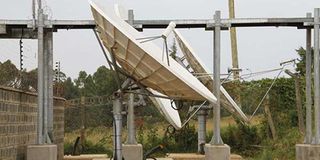Counties use space technology to improve service delivery

A satellite transmission station. Some three counties have begun adopting the deployment of space technologies and geographic information systems to facilitate planning and management. PHOTO | FILE | NATION MEDIA GROUP
What you need to know:
- County Governments Act, 2012 requires the devolved units to embrace spatial technologies in management of their affairs.
- According to the CoG, GIS is key in spatial planning and urban development.
- The platform can also show the state of the environment like forest cover.
Some three counties have begun adopting the deployment of space technologies and geographic information systems (GIS) to facilitate planning and management.
GIS uses location-based data collected via satellites, paper maps, and directly from the field through mobile positioning devices to map out resources for analysis and decision-making
The County Governments Act, 2012 requires the devolved units to embrace spatial technologies in management of their affairs but many are yet to correctly implement this part of the law.
SPATIAL PLAN
Counties are obliged to prepare a 10-year GIS-based spatial plan which will be a component part of the County Integrated Development Plan (CIDP).
Baringo, Nandi and Vihiga will this week launch their fully operational GIS labs, according to a statement from the Council of Governors (CoG).
Different partners have donated satellite image and GIS software to help the three counties efficiently manage their resources such as forests, water, farmlands, minerals, wildlife and wetlands.
According to the CoG, GIS is key in spatial planning and urban development, digitisation and management of land parcels, data records, automation of land services and land use zoning.
INFORMATION MANAGEMENT
The system is also good in land information management and infrastructure development where it is used to analyse current property types, access routes, land ownership, property demand and local demographics.
The GIS is a system of hardware, software, and procedures designed to support the capture, management, manipulation, analysis, modelling and display of spatially-referenced data for solving complex planning and management problems.
REPLICATION
This platform can easily be replicated in any of the 47 counties capturing different details including priority needs directly collected from residents of a particular county.
The platform can also show the state of the environment like forest cover as a percentage of total land in a county, people’s economic activities, distribution of government-funded projects, population distribution as well as the state of roads across a county.
“We encourage all county governments to quickly uptake this technology as it is required in law and for their own benefit in service delivery,” said the CoG in a statement.





